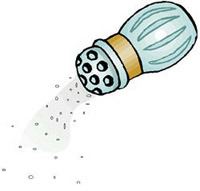Less salt in our food supply could save at least a half-million Americans from dying prematurely over the next ten years, according to separate studies conducted at three universities, two American and one Canadian.
If the average daily salt intake were to drop to 1,500 milligrams, as recommended by the Dietary Guidelines for Americans, the number of lives saved could more than double. All study results were published in the medical journal Hypertension (http://bit.ly/Z7X6v6), a publication of the American Heart Association (AHA).
Americans currently consume on average 3,600 milligrams of salt daily, mostly in form of sodium, widely used as an ingredient in processed foods. Sodium is considered a significant contributor to high blood pressure, which can lead to heart disease, heart attack and stroke, all of which are leading causes of death in the U.S. today.
About a third of American adults, or 68 million, suffer from high blood pressure, a.k.a. hypertension, according to the Centers for Disease Control and Prevention (CDC). The condition was identified as a primary or contributing cause of nearly 350,000 deaths in the U.S. in 2008, the last time the CDC has updated its research on the subject.
Despite of these alarming statistics, there are currently no signs of improvement. Even better treatment has only shown mixed results. Less than half (46 percent) of high blood pressure patients have their condition under control, according to the CDC.
Because the salt content in processed food is already added before it reaches the consumer, there is little opportunity to make changes on an individual basis other than limiting one’s choices to fresh items like produce. This would also exclude many options in restaurants.
“Individuals can’t make this choice easily,” said Dr. Kirstin Bibbins-Domingo, professor of medicine and epidemiology at the University of California, San Francisco (UCSF), to ABC News. “So maybe we should find ways to work with the food industry,” she suggested.
The National Salt Reduction Initiative, a partnership started by the New York City Health Department that has expanded to nearly 100 city and state health organizations across the country, has been trying to get food manufacturers and restaurant operators to cut salt by 25 percent or more since 2008, the year of the organization’s inception. The current goal is to achieve a reduction of 20 percent by 2014.
Little difference?
Critics say that such measures are impractical and would make little difference. Public health advocates have been focusing on hypertension as if no other health threats existed, said Morton Satin, Vice President of science and research at the Salt Institute, a trade association for the salt industry, in response to the recent studies to ABC News. The association warns that low salt intake could produce its own set of health problems, especially for the elderly.
While most experts would agree that multiple factors can be responsible for the development of high blood pressure, including genetic predisposition, gender, age and other non-modifiable components, poor diet and lifestyle choices, which are modifiable and therefore preventable risk factors, usually play a much greater role.
In a milestone conference on the connections between sodium intake and blood pressure, sponsored by the National Heart, Lung and Blood Institute (NHLBI), the participating scientists concluded that “an abundance of scientific evidence indicates that higher sodium consumption is associated with higher levels of blood pressure, [as demonstrated in] animal studies, observational epidemiologic studies, and clinical studies and trials.” They were also hopeful that more effective strategies could be developed to improve diet and lifestyles patterns that benefit the larger population.
Timi Gustafson R.D. is a registered dietitian, newspaper columnist, blogger and author of the book “The Healthy Diner – How to Eat Right and Still Have Fun”®, which is available on her blog and at amazon.com. For more articles on nutrition, health and lifestyle, visit her blog, “Food and Health with Timi Gustafson R.D.” (www.timigustafson.com). You can follow Timi on Twitter (http://twitter.com/TimiGustafsonRD) and on Facebook.


